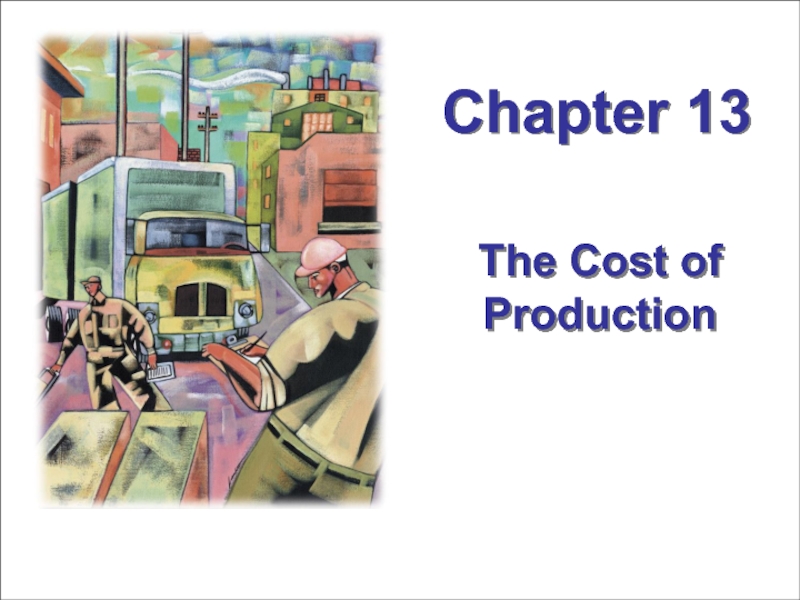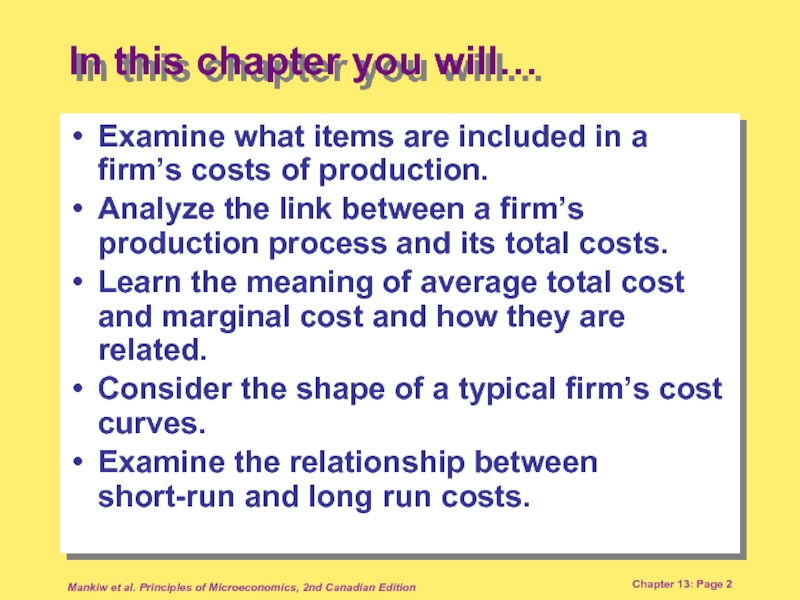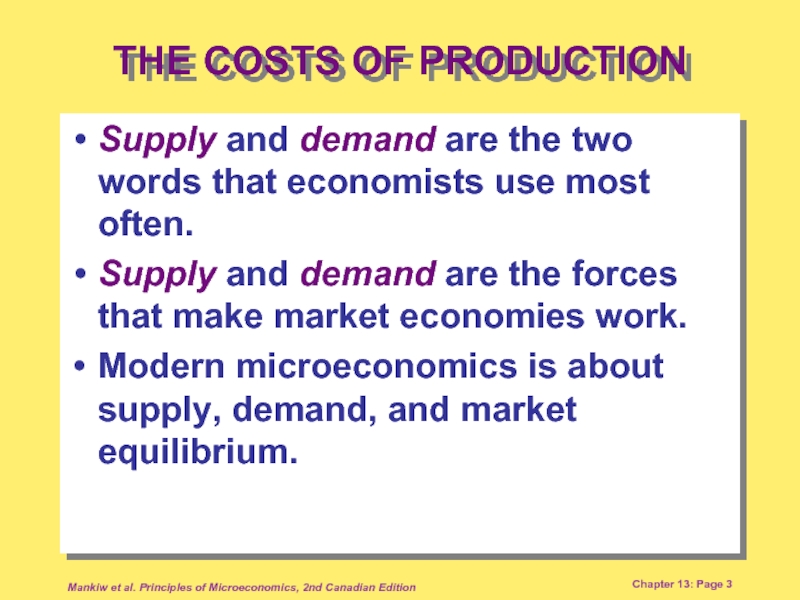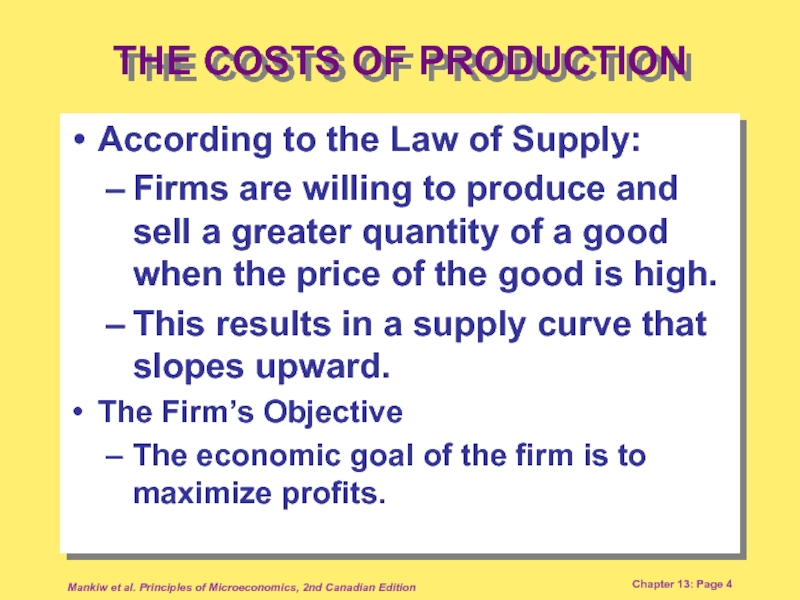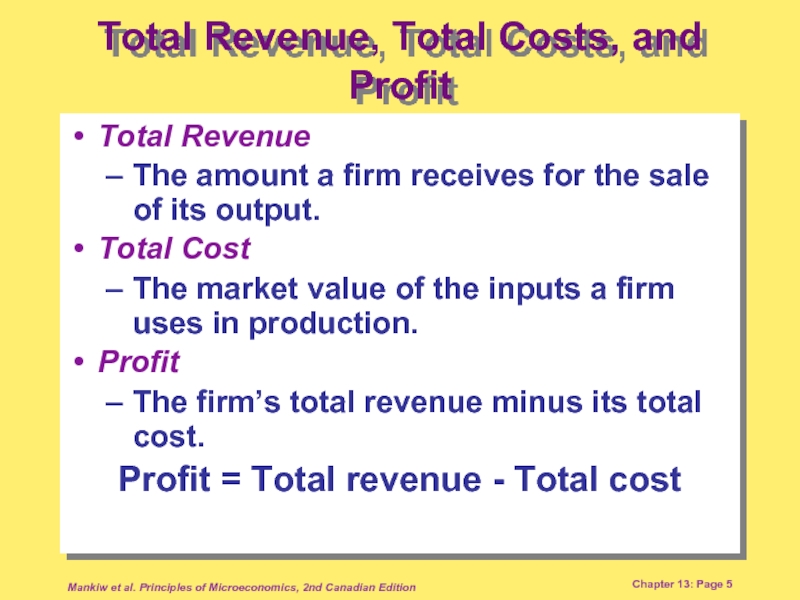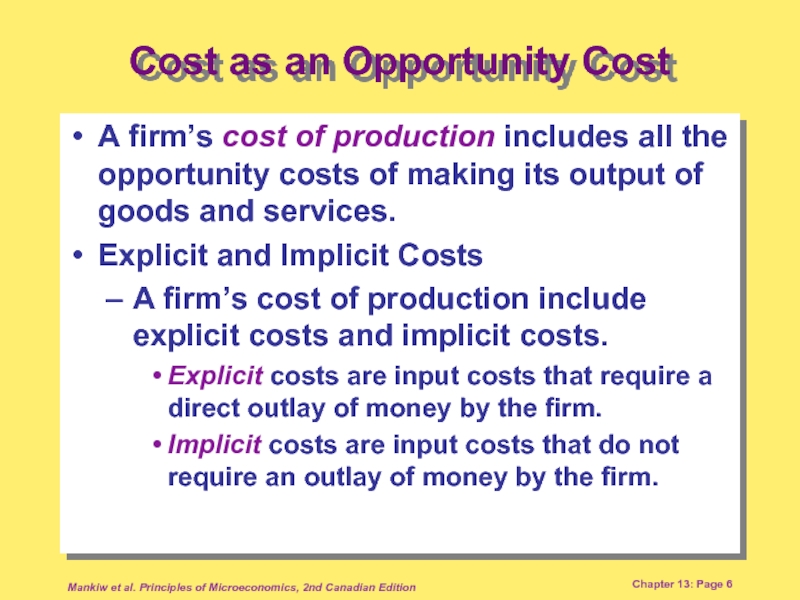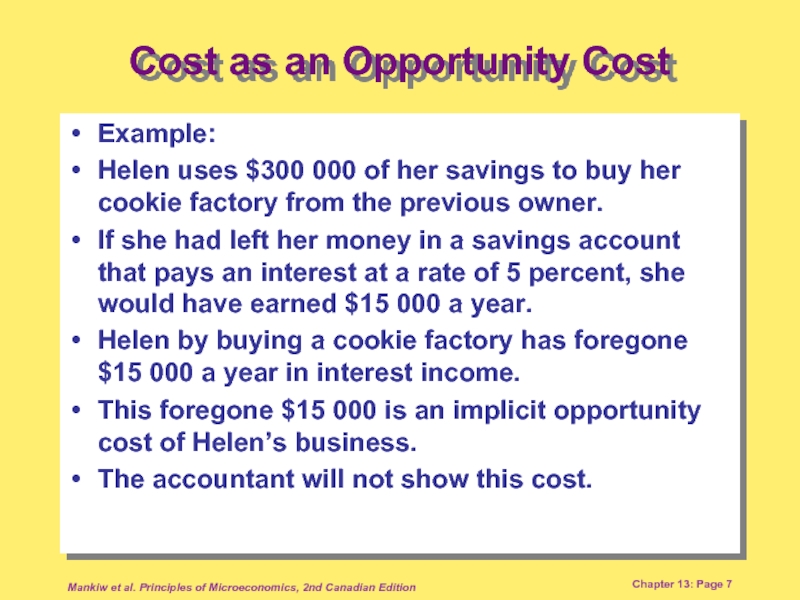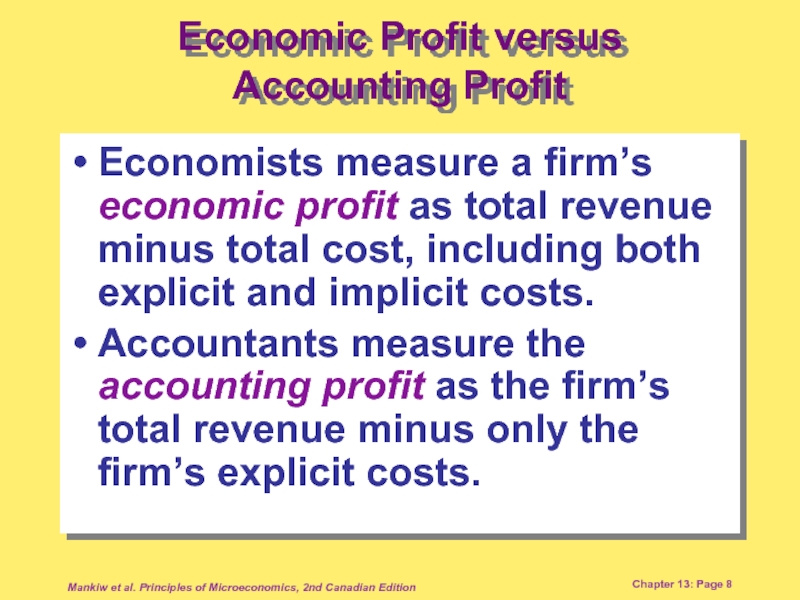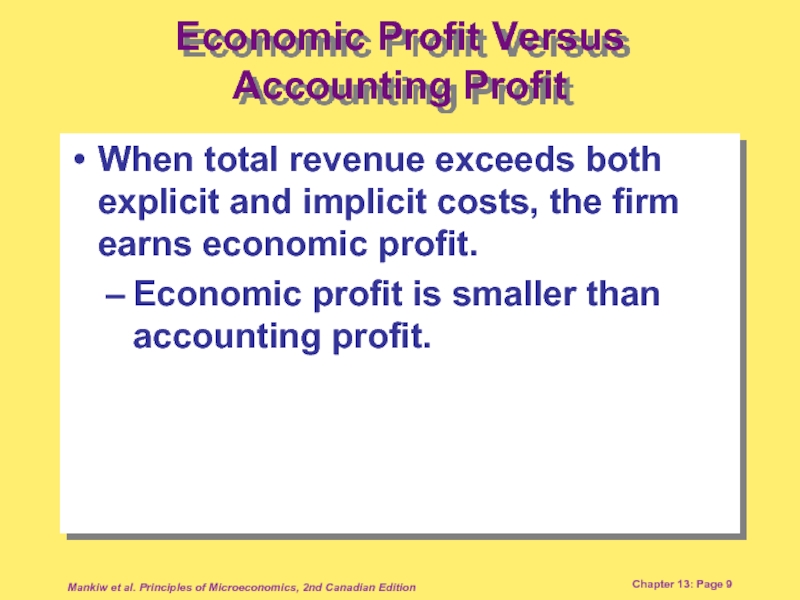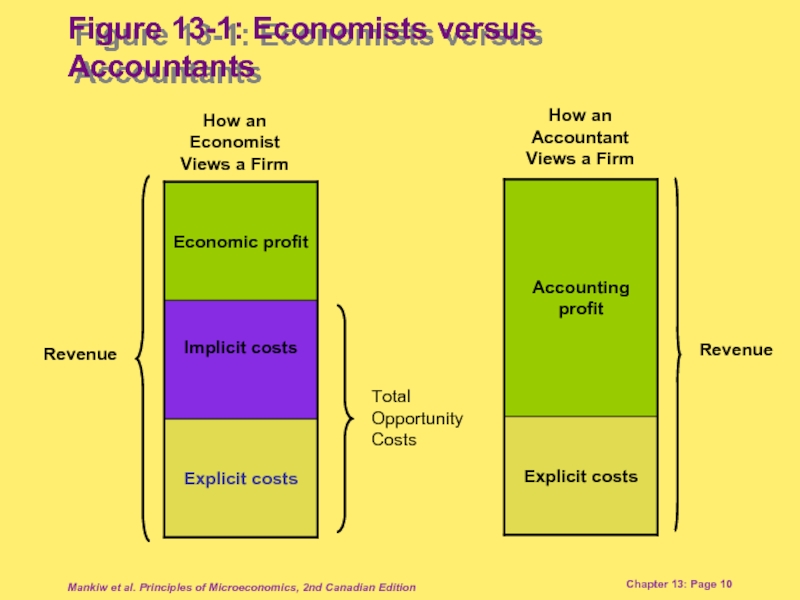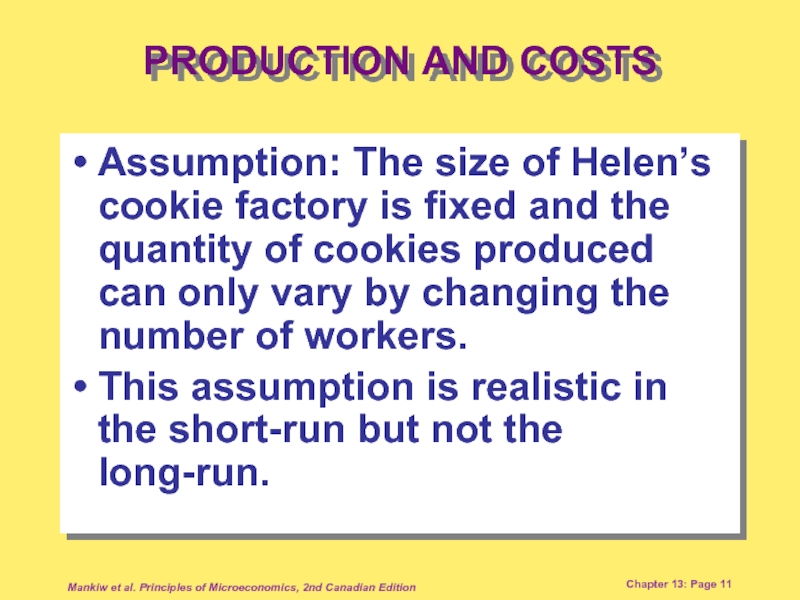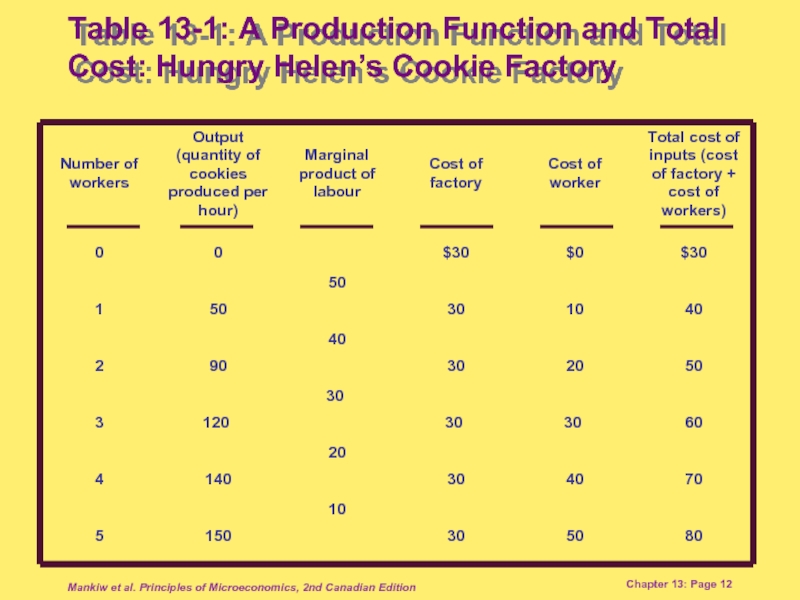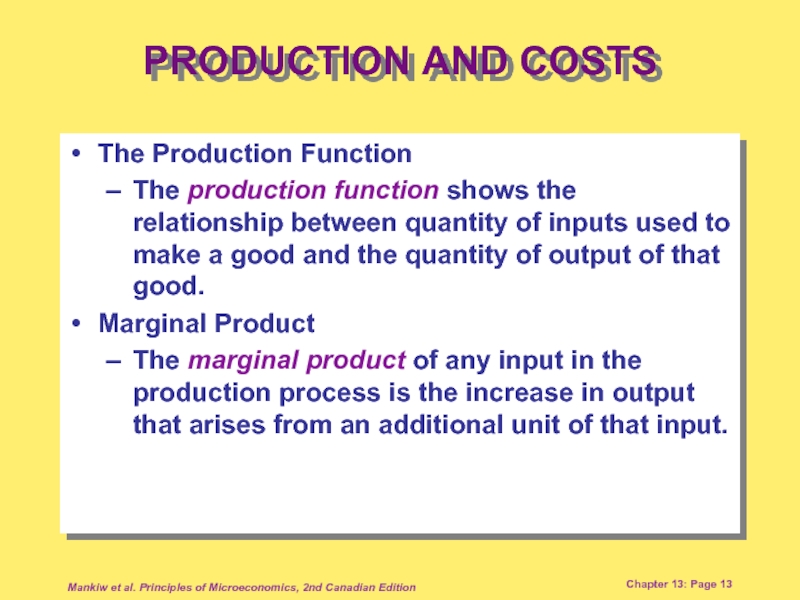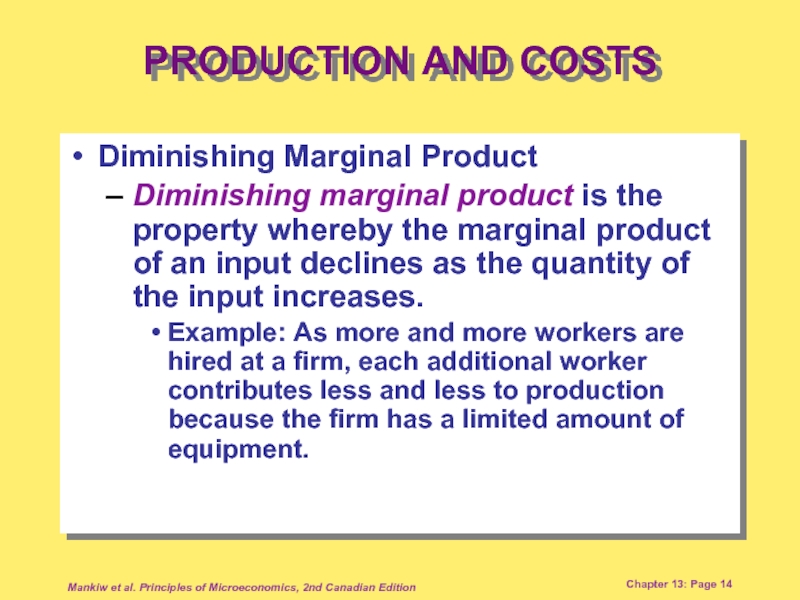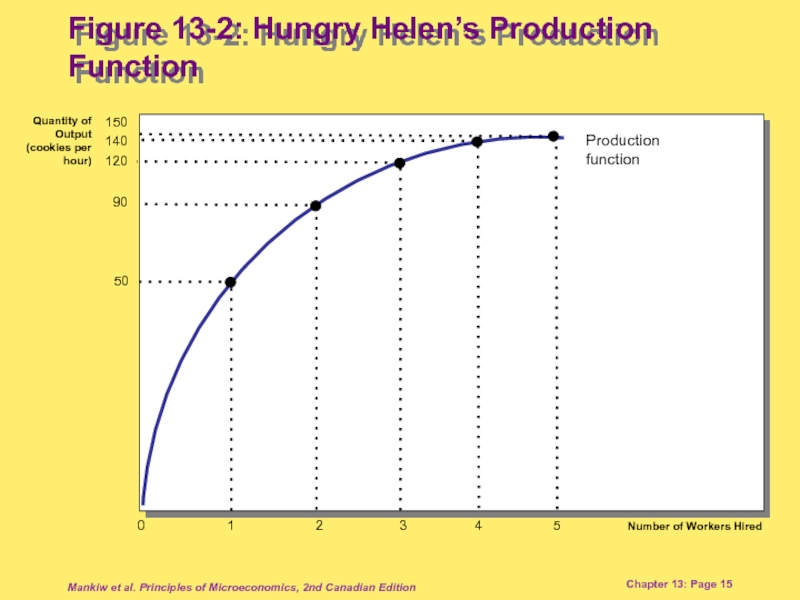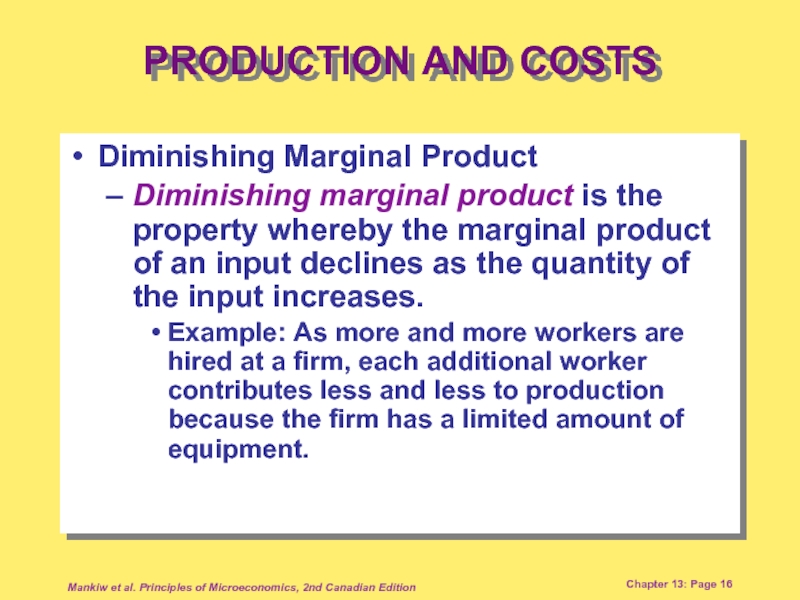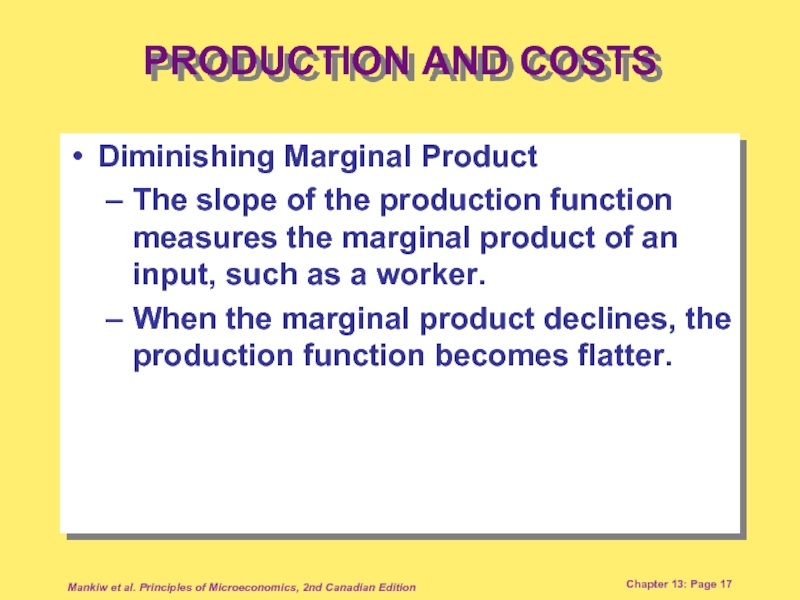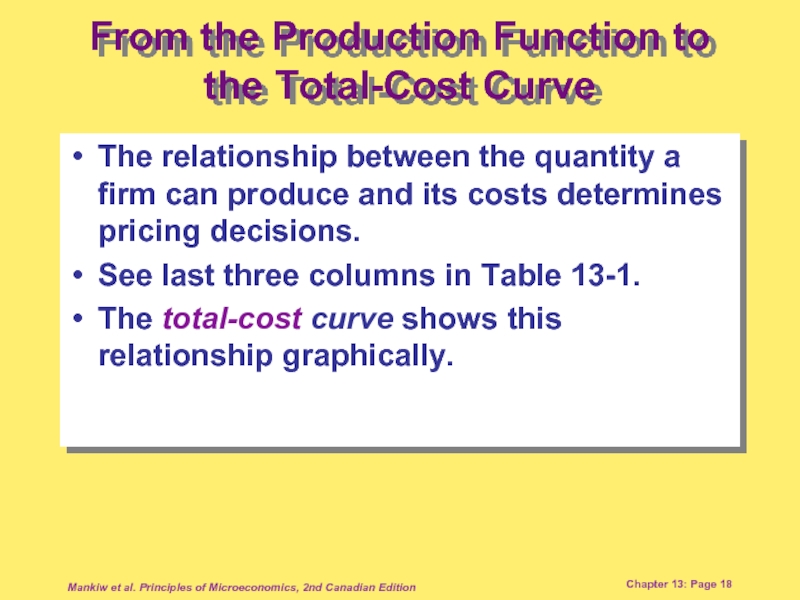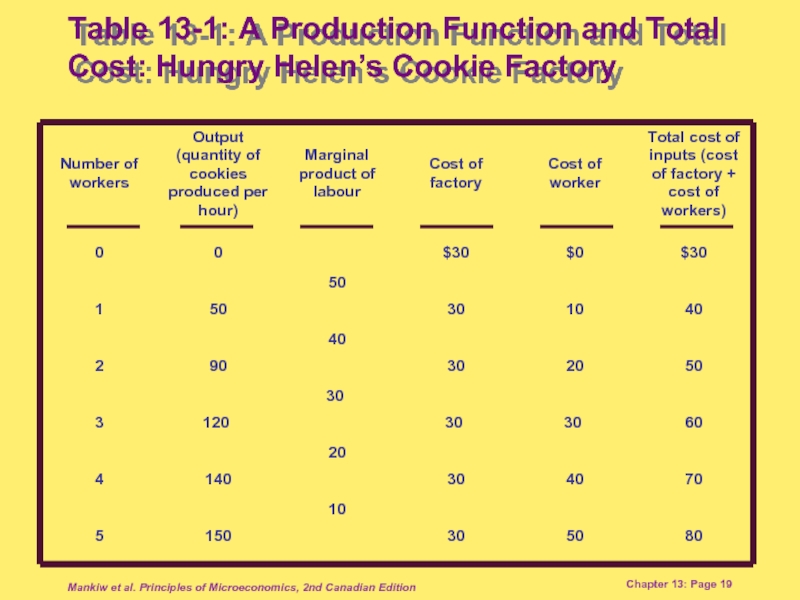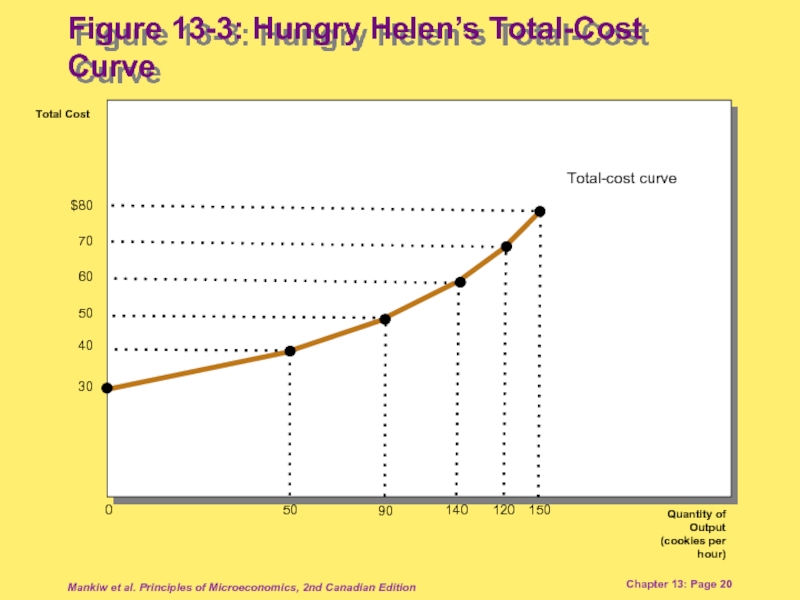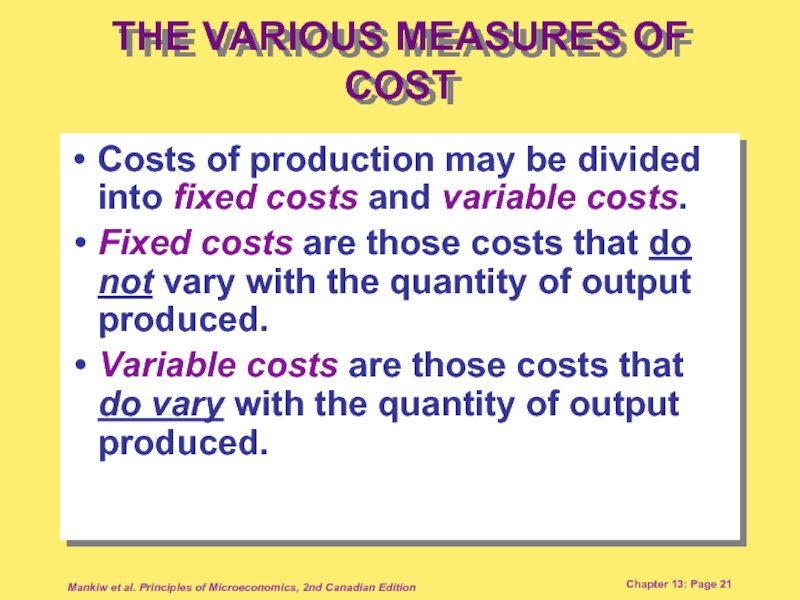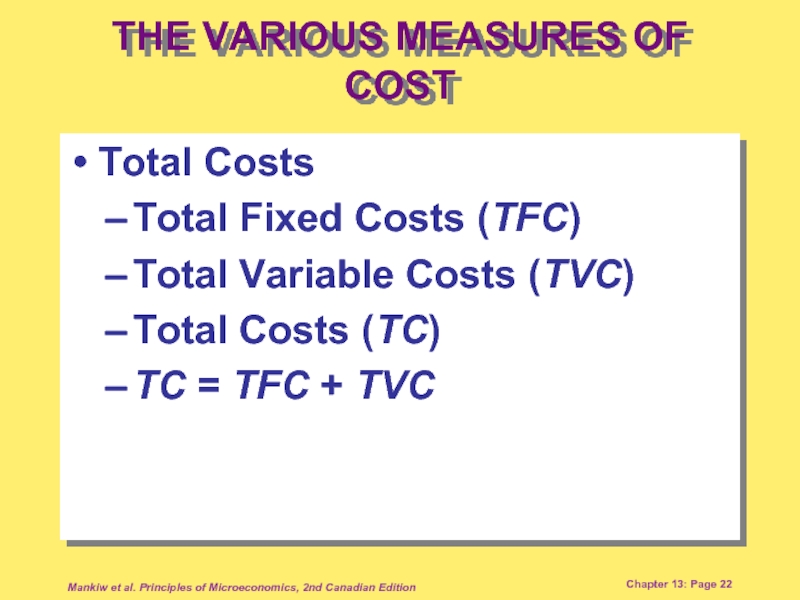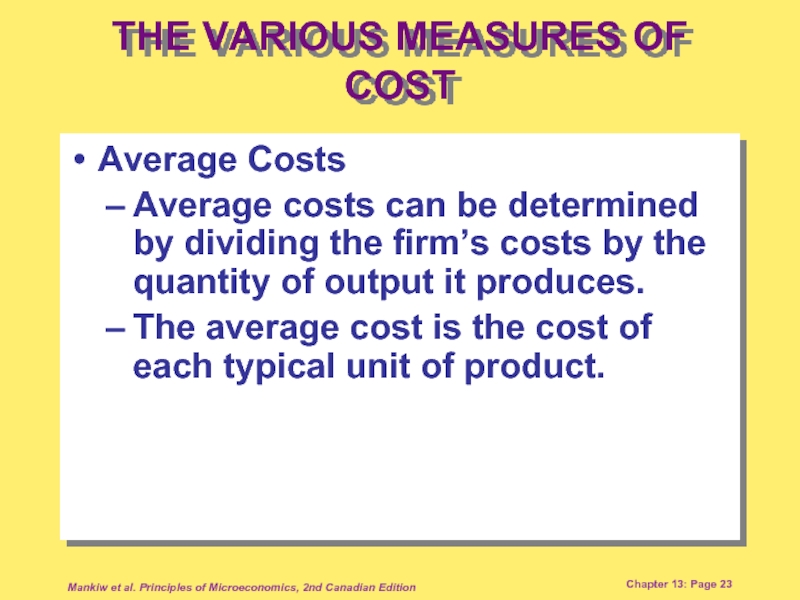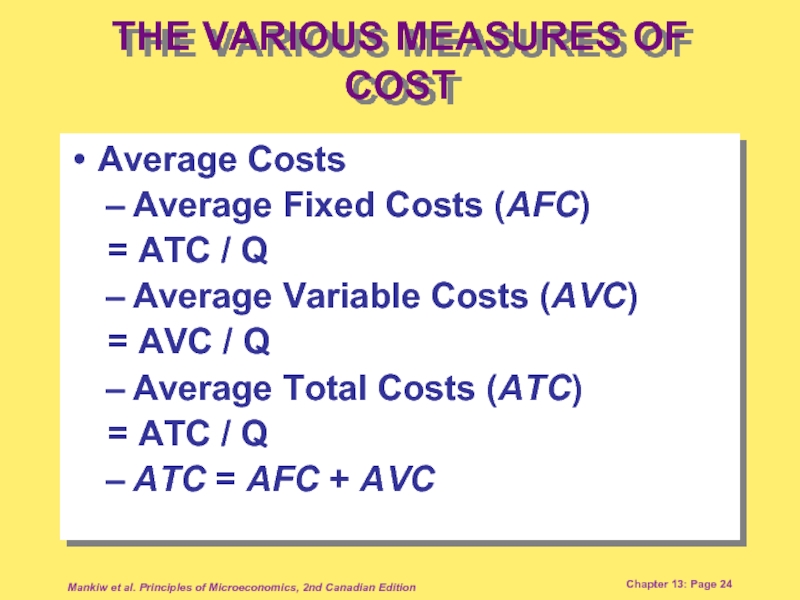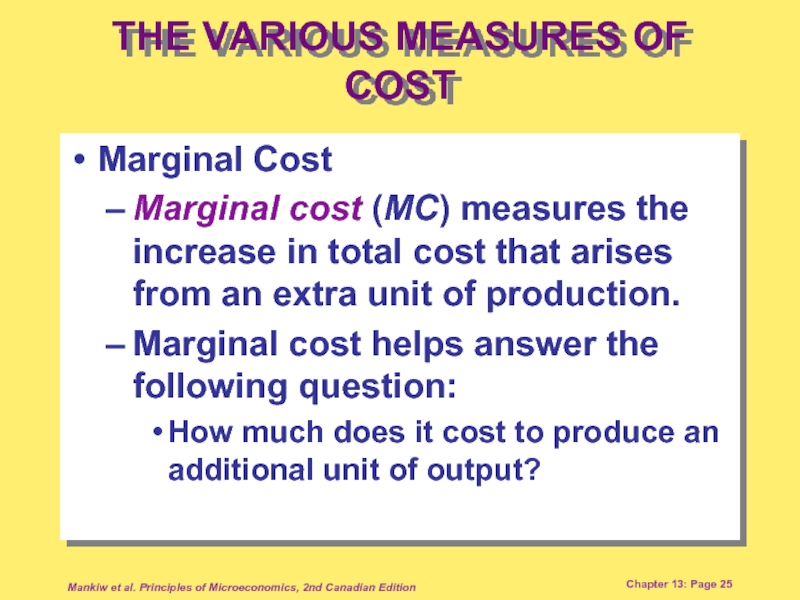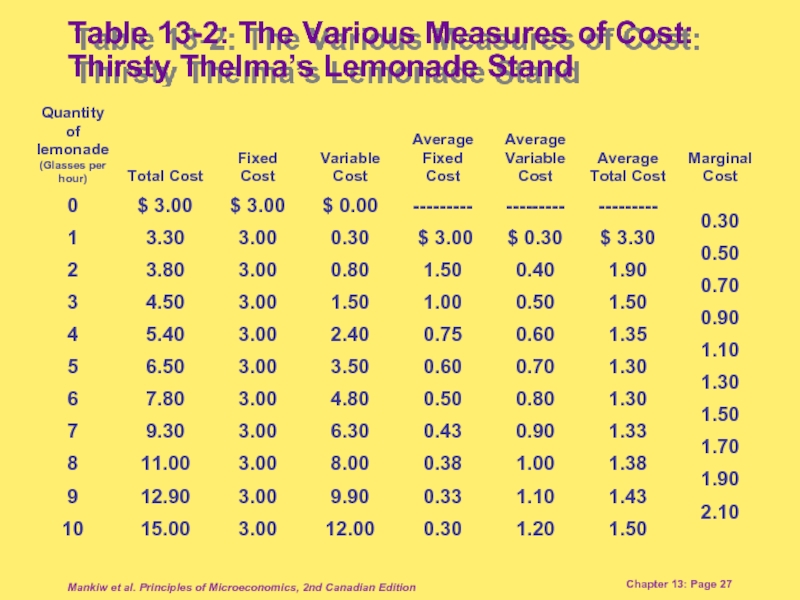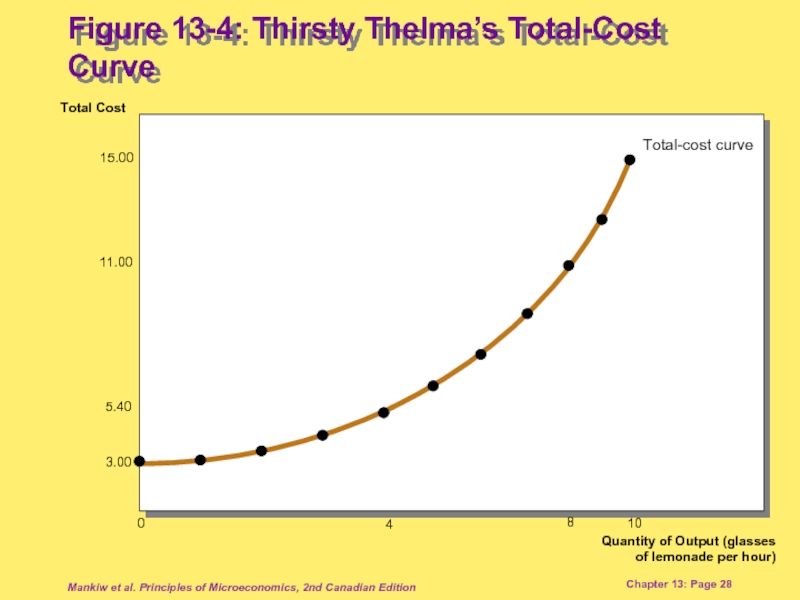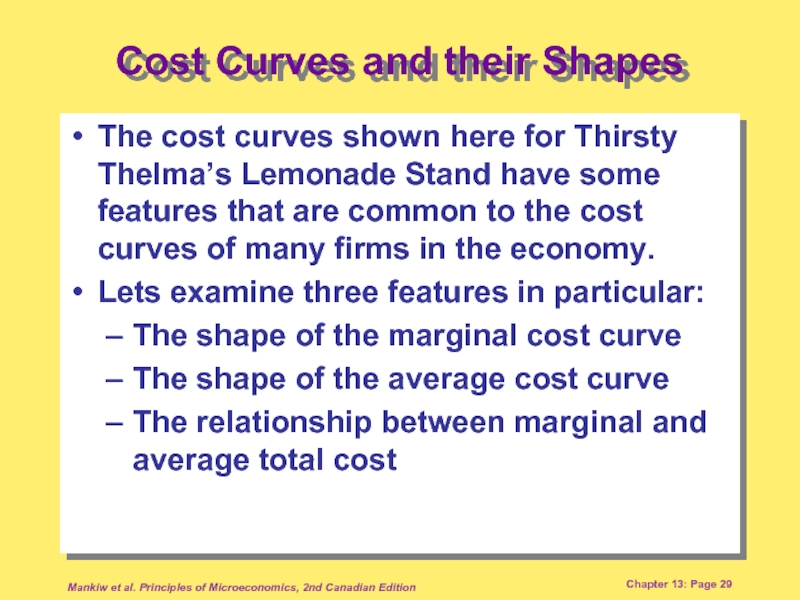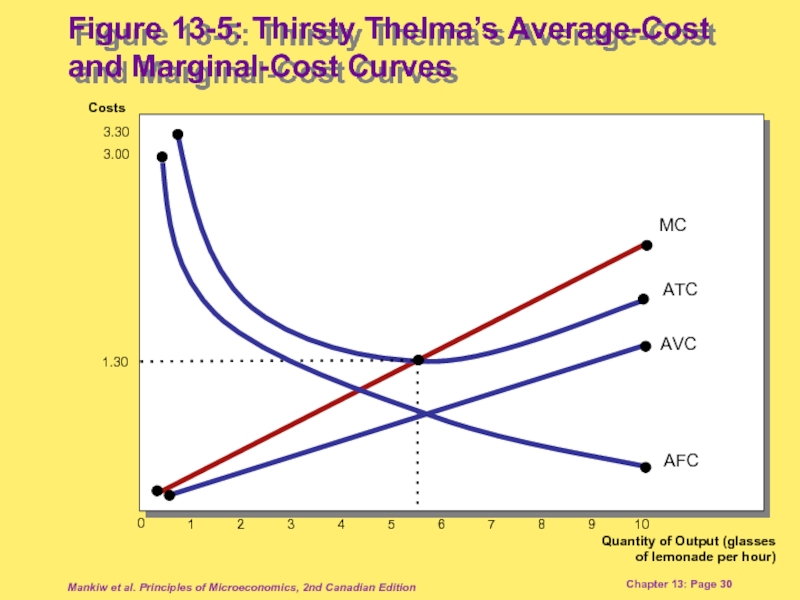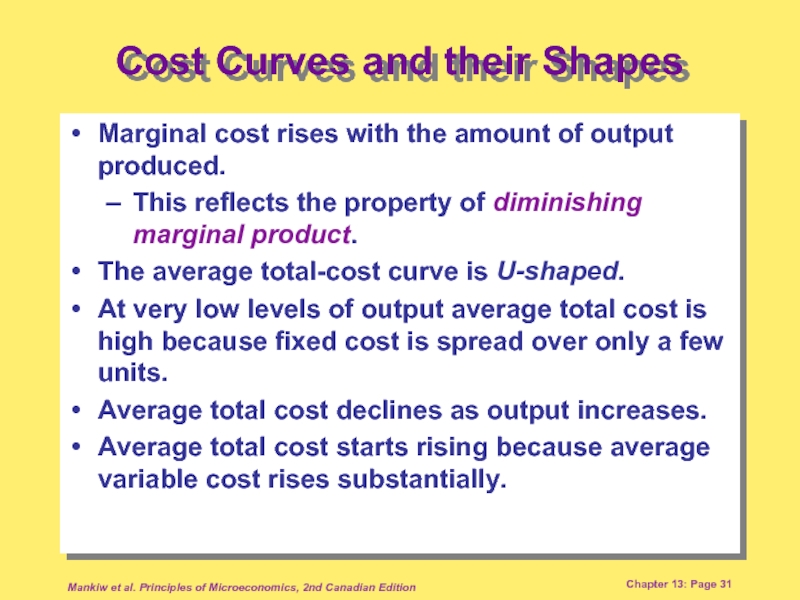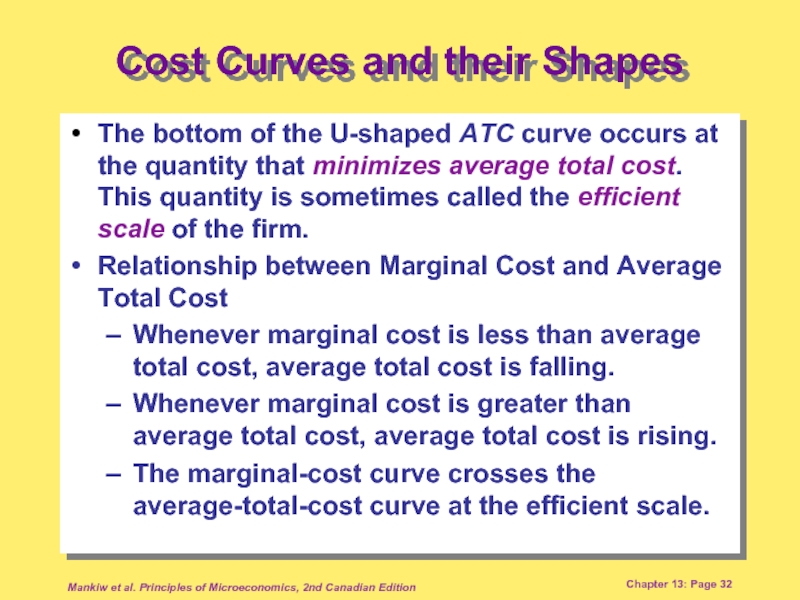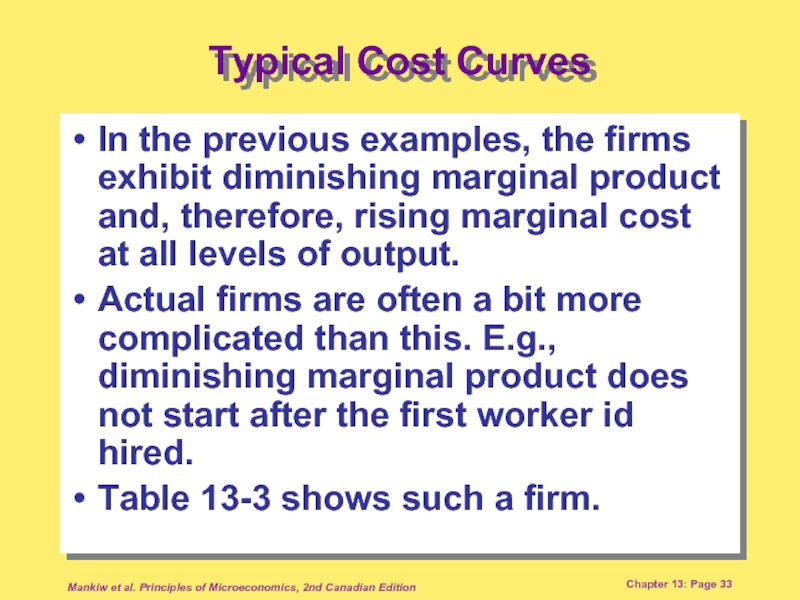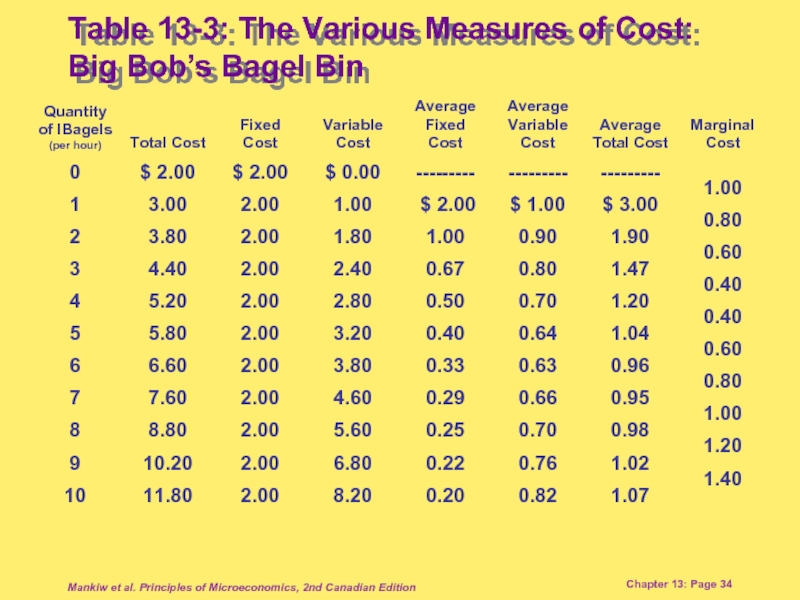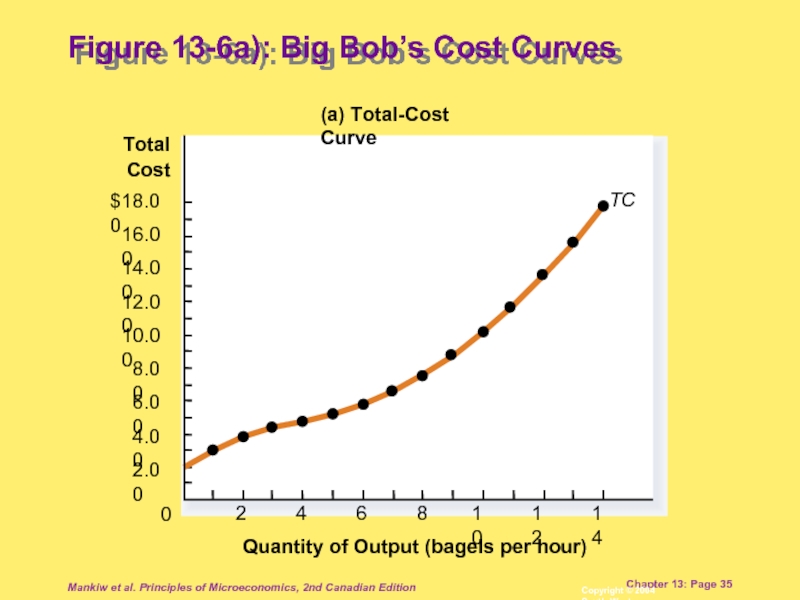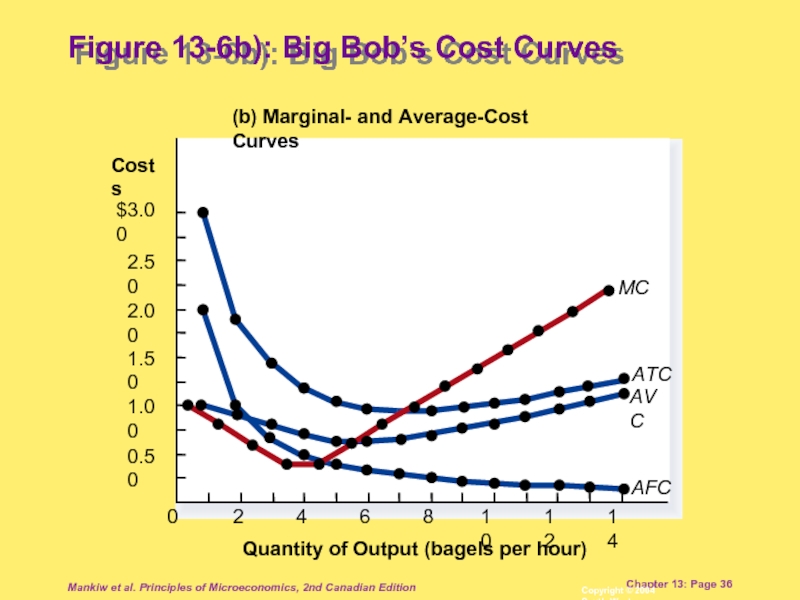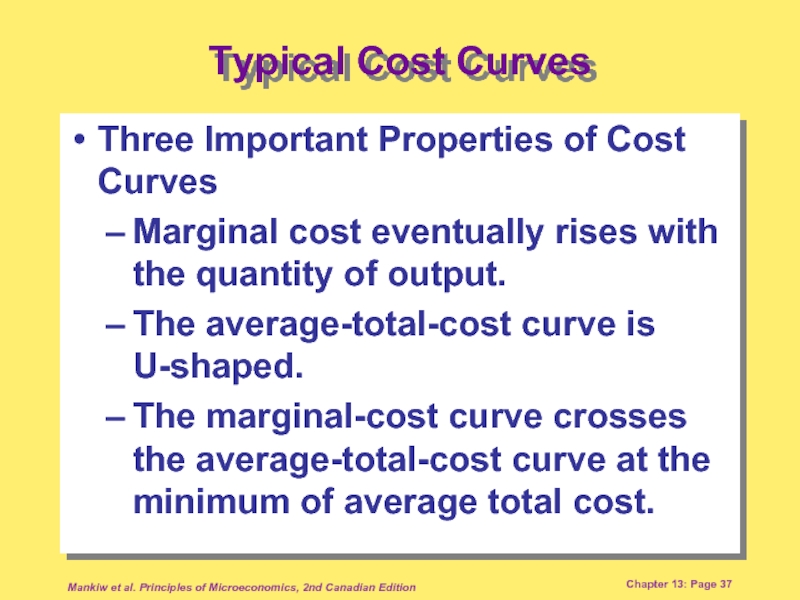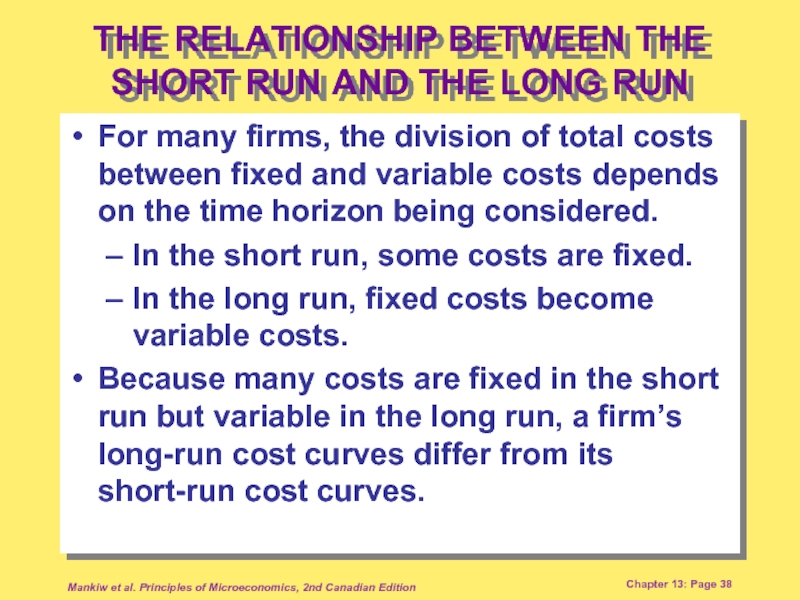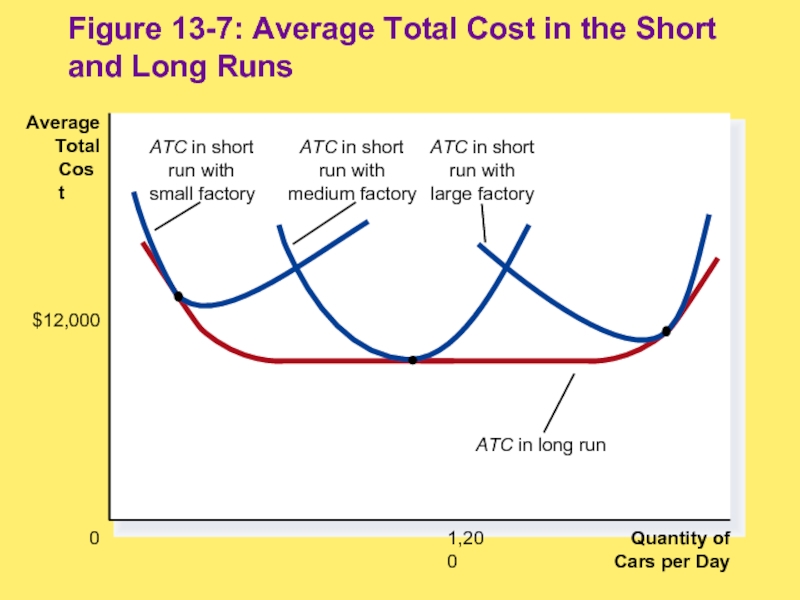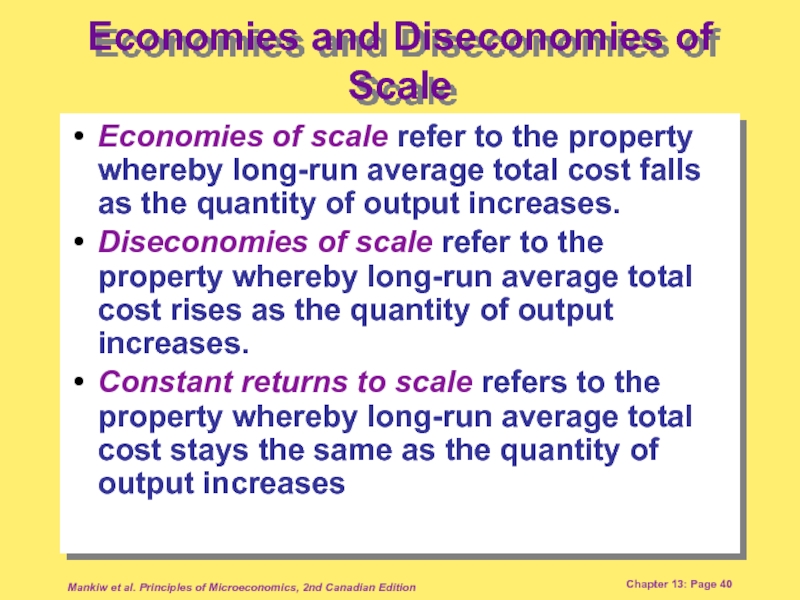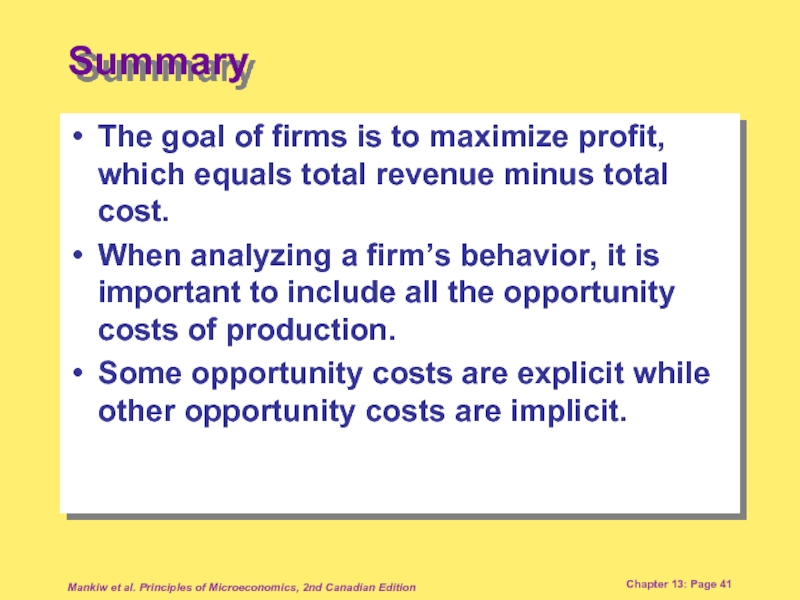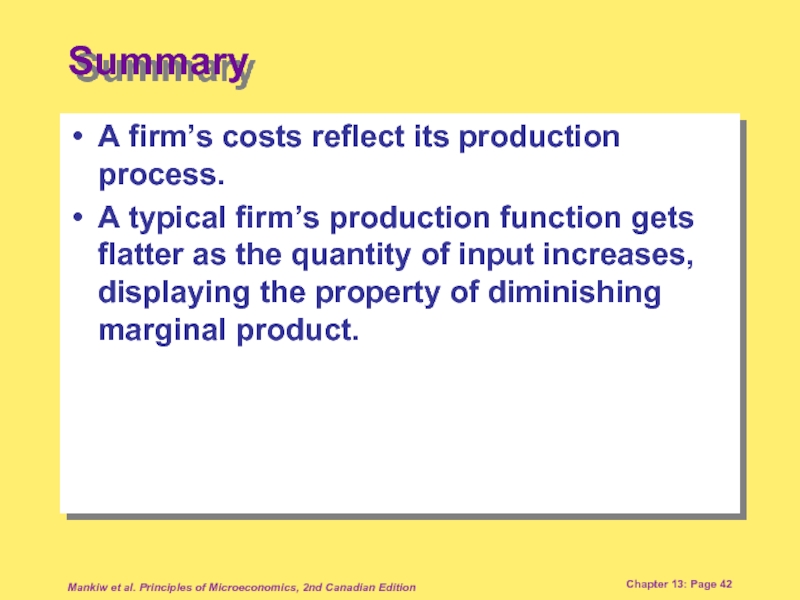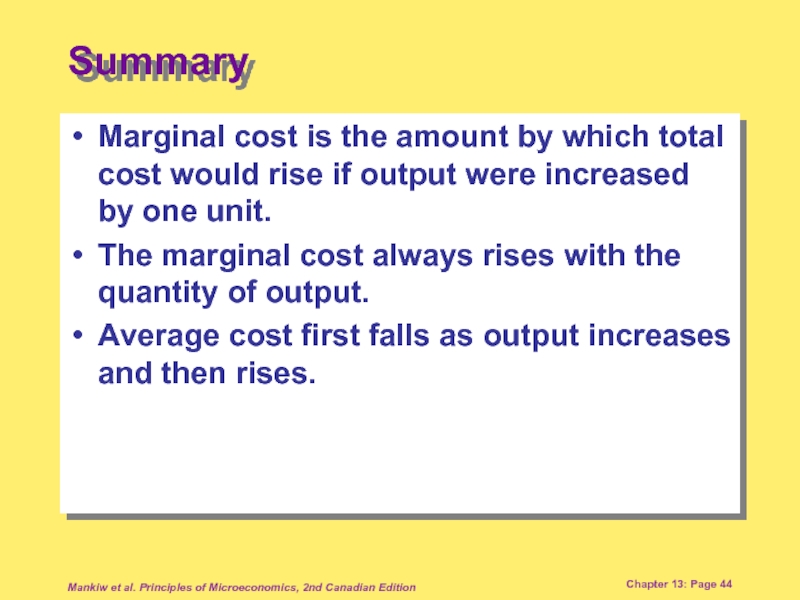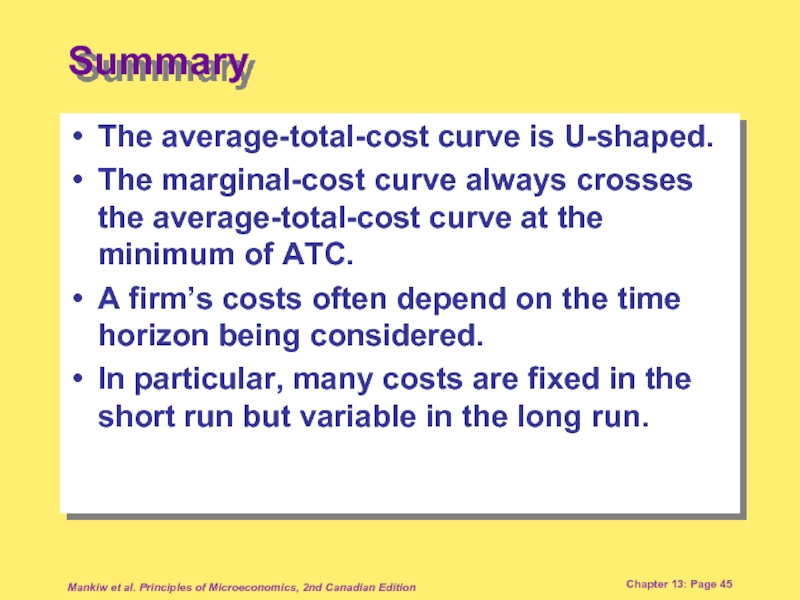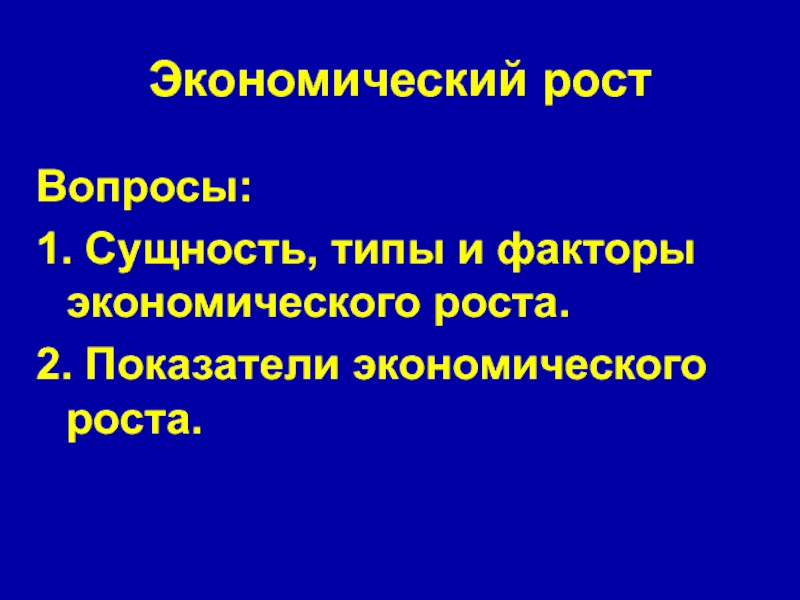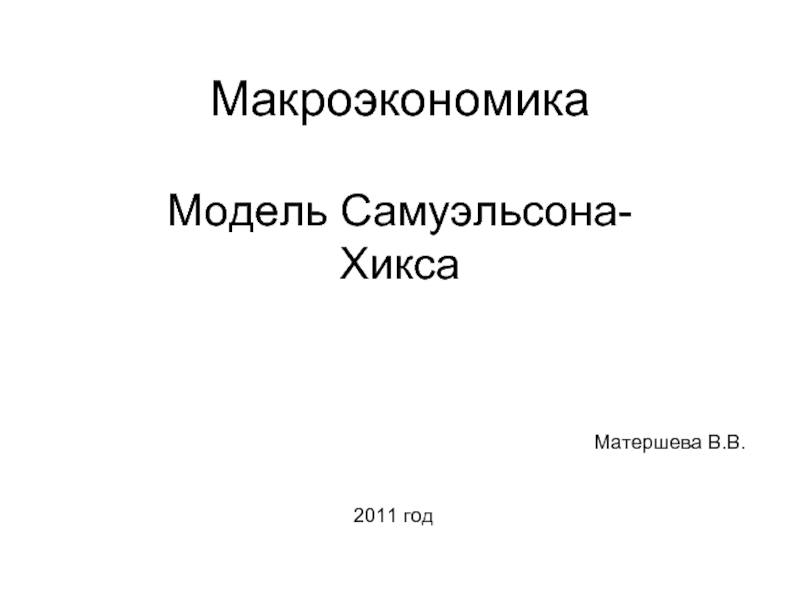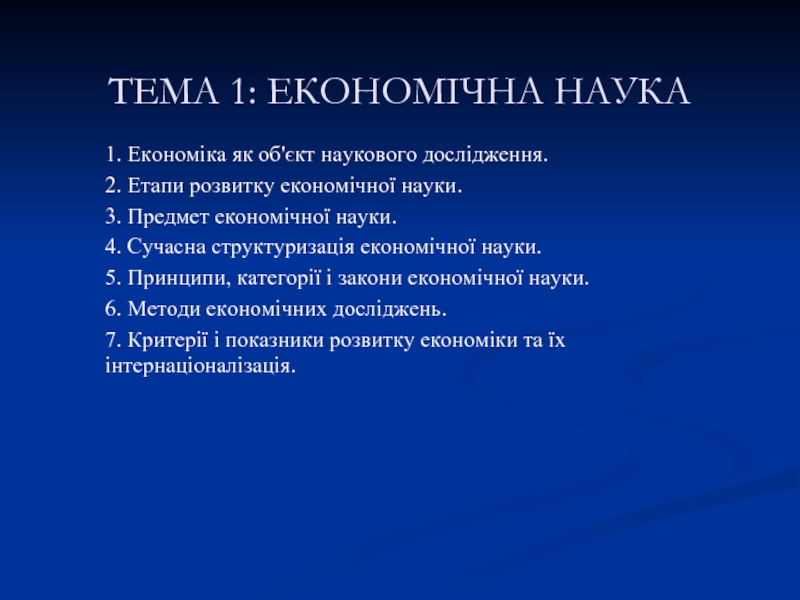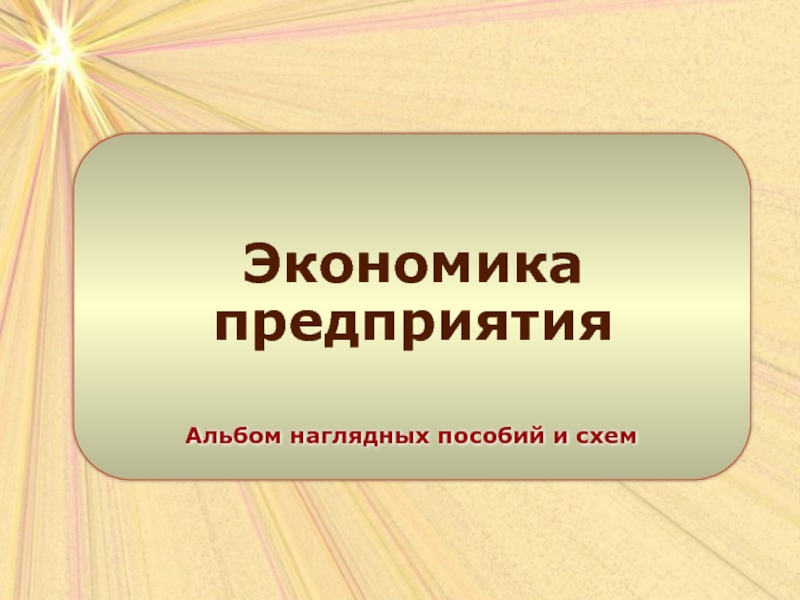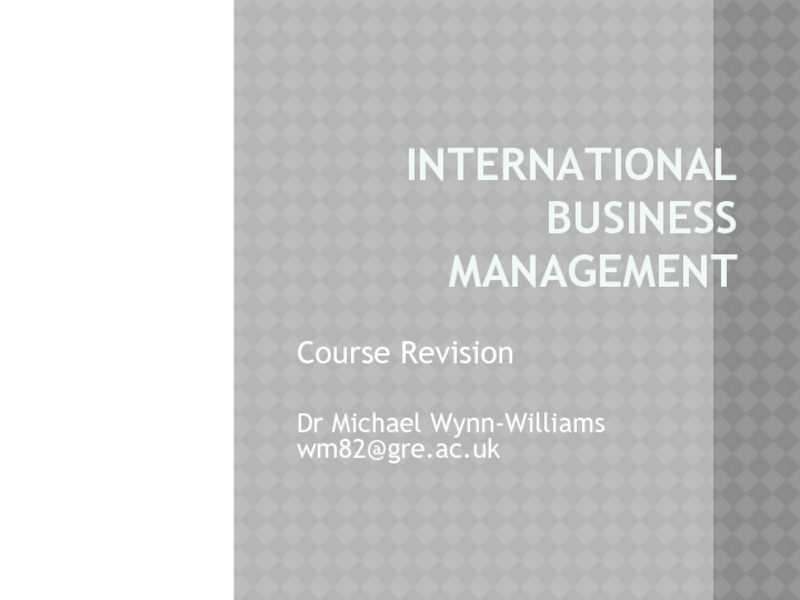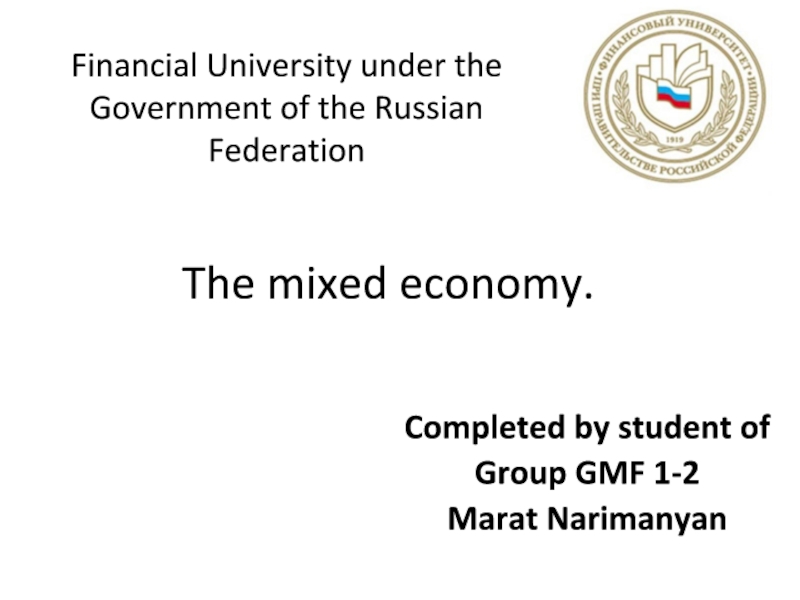- Главная
- Разное
- Дизайн
- Бизнес и предпринимательство
- Аналитика
- Образование
- Развлечения
- Красота и здоровье
- Финансы
- Государство
- Путешествия
- Спорт
- Недвижимость
- Армия
- Графика
- Культурология
- Еда и кулинария
- Лингвистика
- Английский язык
- Астрономия
- Алгебра
- Биология
- География
- Детские презентации
- Информатика
- История
- Литература
- Маркетинг
- Математика
- Медицина
- Менеджмент
- Музыка
- МХК
- Немецкий язык
- ОБЖ
- Обществознание
- Окружающий мир
- Педагогика
- Русский язык
- Технология
- Физика
- Философия
- Химия
- Шаблоны, картинки для презентаций
- Экология
- Экономика
- Юриспруденция
Chapter 13. The Cost of Production презентация
Содержание
- 1. Chapter 13. The Cost of Production
- 2. Mankiw et al. Principles of Microeconomics, 2nd
- 3. Mankiw et al. Principles of Microeconomics, 2nd
- 4. Mankiw et al. Principles of Microeconomics, 2nd
- 5. Mankiw et al. Principles of Microeconomics, 2nd
- 6. Mankiw et al. Principles of Microeconomics, 2nd
- 7. Mankiw et al. Principles of Microeconomics, 2nd
- 8. Mankiw et al. Principles of Microeconomics, 2nd
- 9. Mankiw et al. Principles of Microeconomics, 2nd
- 10. Mankiw et al. Principles of Microeconomics, 2nd
- 11. Mankiw et al. Principles of Microeconomics, 2nd
- 12. Mankiw et al. Principles of Microeconomics, 2nd
- 13. Mankiw et al. Principles of Microeconomics, 2nd
- 14. Mankiw et al. Principles of Microeconomics, 2nd
- 15. Mankiw et al. Principles of Microeconomics, 2nd
- 16. Mankiw et al. Principles of Microeconomics, 2nd
- 17. Mankiw et al. Principles of Microeconomics, 2nd
- 18. Mankiw et al. Principles of Microeconomics, 2nd
- 19. Mankiw et al. Principles of Microeconomics, 2nd
- 20. Mankiw et al. Principles of Microeconomics, 2nd
- 21. Mankiw et al. Principles of Microeconomics, 2nd
- 22. Mankiw et al. Principles of Microeconomics, 2nd
- 23. Mankiw et al. Principles of Microeconomics, 2nd
- 24. Mankiw et al. Principles of Microeconomics, 2nd
- 25. Mankiw et al. Principles of Microeconomics, 2nd
- 26. Mankiw et al. Principles of Microeconomics, 2nd
- 27. Mankiw et al. Principles of Microeconomics, 2nd
- 28. Mankiw et al. Principles of Microeconomics, 2nd
- 29. Mankiw et al. Principles of Microeconomics, 2nd
- 30. Mankiw et al. Principles of Microeconomics, 2nd
- 31. Mankiw et al. Principles of Microeconomics, 2nd
- 32. Mankiw et al. Principles of Microeconomics, 2nd
- 33. Mankiw et al. Principles of Microeconomics, 2nd
- 34. Mankiw et al. Principles of Microeconomics, 2nd
- 35. Mankiw et al. Principles of Microeconomics, 2nd
- 36. Mankiw et al. Principles of Microeconomics, 2nd
- 37. Mankiw et al. Principles of Microeconomics, 2nd
- 38. Mankiw et al. Principles of Microeconomics, 2nd
- 40. Mankiw et al. Principles of Microeconomics, 2nd
- 41. Mankiw et al. Principles of Microeconomics, 2nd
- 42. Mankiw et al. Principles of Microeconomics, 2nd
- 43. Mankiw et al. Principles of Microeconomics, 2nd
- 44. Mankiw et al. Principles of Microeconomics, 2nd
- 45. Mankiw et al. Principles of Microeconomics, 2nd
- 46. Mankiw et al. Principles of Microeconomics, 2nd Canadian Edition Chapter 13: Page The End
Слайд 2Mankiw et al. Principles of Microeconomics, 2nd Canadian Edition
Chapter 13: Page
Examine what items are included in a firm’s costs of production.
Analyze the link between a firm’s production process and its total costs.
Learn the meaning of average total cost and marginal cost and how they are related.
Consider the shape of a typical firm’s cost curves.
Examine the relationship between short-run and long run costs.
In this chapter you will…
Слайд 3Mankiw et al. Principles of Microeconomics, 2nd Canadian Edition
Chapter 13: Page
Supply and demand are the two words that economists use most often.
Supply and demand are the forces that make market economies work.
Modern microeconomics is about supply, demand, and market equilibrium.
THE COSTS OF PRODUCTION
Слайд 4Mankiw et al. Principles of Microeconomics, 2nd Canadian Edition
Chapter 13: Page
According to the Law of Supply:
Firms are willing to produce and sell a greater quantity of a good when the price of the good is high.
This results in a supply curve that slopes upward.
The Firm’s Objective
The economic goal of the firm is to maximize profits.
THE COSTS OF PRODUCTION
Слайд 5Mankiw et al. Principles of Microeconomics, 2nd Canadian Edition
Chapter 13: Page
Total Revenue
The amount a firm receives for the sale of its output.
Total Cost
The market value of the inputs a firm uses in production.
Profit
The firm’s total revenue minus its total cost.
Profit = Total revenue - Total cost
Total Revenue, Total Costs, and Profit
Слайд 6Mankiw et al. Principles of Microeconomics, 2nd Canadian Edition
Chapter 13: Page
A firm’s cost of production includes all the opportunity costs of making its output of goods and services.
Explicit and Implicit Costs
A firm’s cost of production include explicit costs and implicit costs.
Explicit costs are input costs that require a direct outlay of money by the firm.
Implicit costs are input costs that do not require an outlay of money by the firm.
Cost as an Opportunity Cost
Слайд 7Mankiw et al. Principles of Microeconomics, 2nd Canadian Edition
Chapter 13: Page
Example:
Helen uses $300 000 of her savings to buy her cookie factory from the previous owner.
If she had left her money in a savings account that pays an interest at a rate of 5 percent, she would have earned $15 000 a year.
Helen by buying a cookie factory has foregone $15 000 a year in interest income.
This foregone $15 000 is an implicit opportunity cost of Helen’s business.
The accountant will not show this cost.
Cost as an Opportunity Cost
Слайд 8Mankiw et al. Principles of Microeconomics, 2nd Canadian Edition
Chapter 13: Page
Economists measure a firm’s economic profit as total revenue minus total cost, including both explicit and implicit costs.
Accountants measure the accounting profit as the firm’s total revenue minus only the firm’s explicit costs.
Economic Profit versus Accounting Profit
Слайд 9Mankiw et al. Principles of Microeconomics, 2nd Canadian Edition
Chapter 13: Page
When total revenue exceeds both explicit and implicit costs, the firm earns economic profit.
Economic profit is smaller than accounting profit.
Economic Profit Versus Accounting Profit
Слайд 10Mankiw et al. Principles of Microeconomics, 2nd Canadian Edition
Chapter 13: Page
How an Economist Views a Firm
Explicit costs
Implicit costs
Economic profit
Explicit costs
Accounting profit
How an Accountant Views a Firm
Figure 13-1: Economists versus Accountants
Слайд 11Mankiw et al. Principles of Microeconomics, 2nd Canadian Edition
Chapter 13: Page
Assumption: The size of Helen’s cookie factory is fixed and the quantity of cookies produced can only vary by changing the number of workers.
This assumption is realistic in the short-run but not the long-run.
PRODUCTION AND COSTS
Слайд 12Mankiw et al. Principles of Microeconomics, 2nd Canadian Edition
Chapter 13: Page
Table 13-1: A Production Function and Total Cost: Hungry Helen’s Cookie Factory
5
4
3
2
1
0
Total cost of inputs (cost of factory + cost of workers)
Cost of worker
Cost of factory
Marginal product of labour
Output (quantity of cookies produced per hour)
Number of workers
Слайд 13Mankiw et al. Principles of Microeconomics, 2nd Canadian Edition
Chapter 13: Page
The Production Function
The production function shows the relationship between quantity of inputs used to make a good and the quantity of output of that good.
Marginal Product
The marginal product of any input in the production process is the increase in output that arises from an additional unit of that input.
PRODUCTION AND COSTS
Слайд 14Mankiw et al. Principles of Microeconomics, 2nd Canadian Edition
Chapter 13: Page
Diminishing Marginal Product
Diminishing marginal product is the property whereby the marginal product of an input declines as the quantity of the input increases.
Example: As more and more workers are hired at a firm, each additional worker contributes less and less to production because the firm has a limited amount of equipment.
PRODUCTION AND COSTS
Слайд 15Mankiw et al. Principles of Microeconomics, 2nd Canadian Edition
Chapter 13: Page
0
Number of Workers Hired
Quantity of Output (cookies per hour)
4
2
1
3
5
Production function
Figure 13-2: Hungry Helen’s Production Function
Слайд 16Mankiw et al. Principles of Microeconomics, 2nd Canadian Edition
Chapter 13: Page
Diminishing Marginal Product
Diminishing marginal product is the property whereby the marginal product of an input declines as the quantity of the input increases.
Example: As more and more workers are hired at a firm, each additional worker contributes less and less to production because the firm has a limited amount of equipment.
PRODUCTION AND COSTS
Слайд 17Mankiw et al. Principles of Microeconomics, 2nd Canadian Edition
Chapter 13: Page
Diminishing Marginal Product
The slope of the production function measures the marginal product of an input, such as a worker.
When the marginal product declines, the production function becomes flatter.
PRODUCTION AND COSTS
Слайд 18Mankiw et al. Principles of Microeconomics, 2nd Canadian Edition
Chapter 13: Page
The relationship between the quantity a firm can produce and its costs determines pricing decisions.
See last three columns in Table 13-1.
The total-cost curve shows this relationship graphically.
From the Production Function to the Total-Cost Curve
Слайд 19Mankiw et al. Principles of Microeconomics, 2nd Canadian Edition
Chapter 13: Page
Table 13-1: A Production Function and Total Cost: Hungry Helen’s Cookie Factory
5
4
3
2
1
0
Total cost of inputs (cost of factory + cost of workers)
Cost of worker
Cost of factory
Marginal product of labour
Output (quantity of cookies produced per hour)
Number of workers
Слайд 20Mankiw et al. Principles of Microeconomics, 2nd Canadian Edition
Chapter 13: Page
0
Total Cost
Quantity of Output (cookies per hour)
Total-cost curve
Figure 13-3: Hungry Helen’s Total-Cost Curve
Слайд 21Mankiw et al. Principles of Microeconomics, 2nd Canadian Edition
Chapter 13: Page
Costs of production may be divided into fixed costs and variable costs.
Fixed costs are those costs that do not vary with the quantity of output produced.
Variable costs are those costs that do vary with the quantity of output produced.
THE VARIOUS MEASURES OF COST
Слайд 22Mankiw et al. Principles of Microeconomics, 2nd Canadian Edition
Chapter 13: Page
Total Costs
Total Fixed Costs (TFC)
Total Variable Costs (TVC)
Total Costs (TC)
TC = TFC + TVC
THE VARIOUS MEASURES OF COST
Слайд 23Mankiw et al. Principles of Microeconomics, 2nd Canadian Edition
Chapter 13: Page
Average Costs
Average costs can be determined by dividing the firm’s costs by the quantity of output it produces.
The average cost is the cost of each typical unit of product.
THE VARIOUS MEASURES OF COST
Слайд 24Mankiw et al. Principles of Microeconomics, 2nd Canadian Edition
Chapter 13: Page
Average Costs
Average Fixed Costs (AFC)
= ATC / Q
Average Variable Costs (AVC)
= AVC / Q
Average Total Costs (ATC)
= ATC / Q
ATC = AFC + AVC
THE VARIOUS MEASURES OF COST
Слайд 25Mankiw et al. Principles of Microeconomics, 2nd Canadian Edition
Chapter 13: Page
Marginal Cost
Marginal cost (MC) measures the increase in total cost that arises from an extra unit of production.
Marginal cost helps answer the following question:
How much does it cost to produce an additional unit of output?
THE VARIOUS MEASURES OF COST
Слайд 26Mankiw et al. Principles of Microeconomics, 2nd Canadian Edition
Chapter 13: Page
Marginal Cost
Marginal cost (MC) measures the increase in total cost that arises from an extra unit of production.
Marginal cost helps answer the following question:
How much does it cost to produce an additional unit of output?
THE VARIOUS MEASURES OF COST
Слайд 27Mankiw et al. Principles of Microeconomics, 2nd Canadian Edition
Chapter 13: Page
Table 13-2: The Various Measures of Cost: Thirsty Thelma’s Lemonade Stand
Marginal Cost
Average Total Cost
Average Variable Cost
Average Fixed Cost
Variable Cost
Fixed Cost
Total Cost
Quantity of lemonade (Glasses per hour)
Слайд 28Mankiw et al. Principles of Microeconomics, 2nd Canadian Edition
Chapter 13: Page
Total Cost
Quantity of Output (glasses of lemonade per hour)
Total-cost curve
4
Figure 13-4: Thirsty Thelma’s Total-Cost Curve
Слайд 29Mankiw et al. Principles of Microeconomics, 2nd Canadian Edition
Chapter 13: Page
Cost Curves and their Shapes
The cost curves shown here for Thirsty Thelma’s Lemonade Stand have some features that are common to the cost curves of many firms in the economy.
Lets examine three features in particular:
The shape of the marginal cost curve
The shape of the average cost curve
The relationship between marginal and average total cost
Слайд 30Mankiw et al. Principles of Microeconomics, 2nd Canadian Edition
Chapter 13: Page
Costs
Quantity of Output (glasses of lemonade per hour)
5
0
3.00
3.30
6
10
7
8
9
4
3
2
1
Figure 13-5: Thirsty Thelma’s Average-Cost and Marginal-Cost Curves
Слайд 31Mankiw et al. Principles of Microeconomics, 2nd Canadian Edition
Chapter 13: Page
Marginal cost rises with the amount of output produced.
This reflects the property of diminishing marginal product.
The average total-cost curve is U-shaped.
At very low levels of output average total cost is high because fixed cost is spread over only a few units.
Average total cost declines as output increases.
Average total cost starts rising because average variable cost rises substantially.
Cost Curves and their Shapes
Слайд 32Mankiw et al. Principles of Microeconomics, 2nd Canadian Edition
Chapter 13: Page
Cost Curves and their Shapes
The bottom of the U-shaped ATC curve occurs at the quantity that minimizes average total cost. This quantity is sometimes called the efficient scale of the firm.
Relationship between Marginal Cost and Average Total Cost
Whenever marginal cost is less than average total cost, average total cost is falling.
Whenever marginal cost is greater than average total cost, average total cost is rising.
The marginal-cost curve crosses the average-total-cost curve at the efficient scale.
Слайд 33Mankiw et al. Principles of Microeconomics, 2nd Canadian Edition
Chapter 13: Page
Typical Cost Curves
In the previous examples, the firms exhibit diminishing marginal product and, therefore, rising marginal cost at all levels of output.
Actual firms are often a bit more complicated than this. E.g., diminishing marginal product does not start after the first worker id hired.
Table 13-3 shows such a firm.
Слайд 34Mankiw et al. Principles of Microeconomics, 2nd Canadian Edition
Chapter 13: Page
Table 13-3: The Various Measures of Cost: Big Bob’s Bagel Bin
Marginal Cost
Average Total Cost
Average Variable Cost
Average Fixed Cost
Variable Cost
Fixed Cost
Total Cost
Quantity of lBagels (per hour)
Слайд 35Mankiw et al. Principles of Microeconomics, 2nd Canadian Edition
Chapter 13: Page
Figure 13-6a): Big Bob’s Cost Curves
Copyright © 2004 South-Western
(a) Total-Cost Curve
$18.00
16.00
14.00
12.00
10.00
8.00
6.00
4.00
Quantity of Output (bagels per hour)
TC
4
2
6
8
14
12
10
2.00
Total
Cost
0
Слайд 36Mankiw et al. Principles of Microeconomics, 2nd Canadian Edition
Chapter 13: Page
Figure 13-6b): Big Bob’s Cost Curves
Copyright © 2004 South-Western
(b) Marginal- and Average-Cost Curves
Quantity of Output (bagels per hour)
Costs
$3.00
2.50
2.00
1.50
1.00
0.50
0
4
2
6
8
14
12
10
MC
ATC
AVC
AFC
Слайд 37Mankiw et al. Principles of Microeconomics, 2nd Canadian Edition
Chapter 13: Page
Typical Cost Curves
Three Important Properties of Cost Curves
Marginal cost eventually rises with the quantity of output.
The average-total-cost curve is U-shaped.
The marginal-cost curve crosses the average-total-cost curve at the minimum of average total cost.
Слайд 38Mankiw et al. Principles of Microeconomics, 2nd Canadian Edition
Chapter 13: Page
THE RELATIONSHIP BETWEEN THE SHORT RUN AND THE LONG RUN
For many firms, the division of total costs between fixed and variable costs depends on the time horizon being considered.
In the short run, some costs are fixed.
In the long run, fixed costs become variable costs.
Because many costs are fixed in the short run but variable in the long run, a firm’s long-run cost curves differ from its short-run cost curves.
Слайд 39
Quantity of
Cars per Day
0
Average
Total
Cost
1,200
$12,000
Figure 13-7: Average Total Cost in the Short
Слайд 40Mankiw et al. Principles of Microeconomics, 2nd Canadian Edition
Chapter 13: Page
Economies and Diseconomies of Scale
Economies of scale refer to the property whereby long-run average total cost falls as the quantity of output increases.
Diseconomies of scale refer to the property whereby long-run average total cost rises as the quantity of output increases.
Constant returns to scale refers to the property whereby long-run average total cost stays the same as the quantity of output increases
Слайд 41Mankiw et al. Principles of Microeconomics, 2nd Canadian Edition
Chapter 13: Page
Summary
The goal of firms is to maximize profit, which equals total revenue minus total cost.
When analyzing a firm’s behavior, it is important to include all the opportunity costs of production.
Some opportunity costs are explicit while other opportunity costs are implicit.
Слайд 42Mankiw et al. Principles of Microeconomics, 2nd Canadian Edition
Chapter 13: Page
Summary
A firm’s costs reflect its production process.
A typical firm’s production function gets flatter as the quantity of input increases, displaying the property of diminishing marginal product.
Слайд 43Mankiw et al. Principles of Microeconomics, 2nd Canadian Edition
Chapter 13: Page
Summary
A firm’s total costs are divided between fixed and variable costs. Fixed costs do not change when the firm alters the quantity of output produced; variable costs do change as the firm alters quantity of output produced.
Average total cost is total cost divided by the quantity of output.
Слайд 44Mankiw et al. Principles of Microeconomics, 2nd Canadian Edition
Chapter 13: Page
Summary
Marginal cost is the amount by which total cost would rise if output were increased by one unit.
The marginal cost always rises with the quantity of output.
Average cost first falls as output increases and then rises.
Слайд 45Mankiw et al. Principles of Microeconomics, 2nd Canadian Edition
Chapter 13: Page
Summary
The average-total-cost curve is U-shaped.
The marginal-cost curve always crosses the average-total-cost curve at the minimum of ATC.
A firm’s costs often depend on the time horizon being considered.
In particular, many costs are fixed in the short run but variable in the long run.
